
Construction
|
|
|
| Menu |
|
Home
About News Kites Kite Design Kite Making - Construction - Plans - Gallery Contributed Skateboards To-do Links |
This page will detail how I build my kites. For now it will not be a start to finish set of instructions on how to build one particular kite but I will keep adding bits as I go along, especially where I do things in an unusual way or where doing it another way might change the way a kite flies.
As ever this is a work in progress so expect things to be missing or broken but also expect to see things being added from time to time so keep coming back.
Cutting Out
I make all my templates without a seam allowance, then I draw around the templates using different sized washers to give me different seam allowances. Usually I tape seams but I do ocassionally do fell seams. After marking the panels I cut them with a disposable box cutter knife snapping the blade of after every panel or two.

It's useful to either waft a little spraymount over the templates or put bits of sail makers tape on them to hold them steady while you cut out BUT! rub over the spraymount with a rag or dab tape with the palm of your hand to take nearly all the tackiness off or you'll really struggle to work with PC31 without everything getting stuck in the wrong places.
Sticking Panels Together
There are a couple of ways I lay out panels, either on to a large sheet of drafting film with the whole kite marked up on it or for prototypes I tape the templates together and lay the panels on to them. Whichever method I use I cover the pattern with bits of tape that I take the tackiness off with the palm of my hand and lay all the panels out, getting the positions perfect before taping the seams. If you use drafting film dont try spraymount rather than tape since it makes it almost impossible to position your fabric.
Leading Edges
Lots of questions get posted to various forums asking how to sew curved leading edges, I've seen suggestions including multipart sewn together leading edges which seem to be a lot of work. Perhaps I'm lucky but I seem to be able to take a length of dacron, fold it and just sew it on. There is no special technique, just try it and practice.
I start by pulling a couple of metres of dacron off the reel and folding it along its length. I apply a little Pritt Stick water soluble adhesive to the top 75mm then wrap it around the sail, tucking the edge of the sail into the fold. Then I start sewing. I use a serpentine stitch (sine wave version of the 3-stitch zig-zag) 4mm wide with a 3mm stich length. I work about 150mm at a time tucking the edge of the sail into the fold:
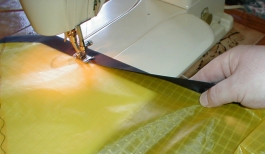
Then close the dacron around it squeezing it to hold the sail in place:

Then sew another 150mm or so, then repeat. Doing a little at a time the dacron follows the shape of the sail with no puckers or creases.
Leading Edge Tensioning
Rather than use bungee for the leading edges, I use a cord: I sew a piece of 150lb rok line between the leading edge dacron and the sail:

I tie a stopper knot 10mm from the last stitch to make a little pigtail. Next I take a length of rok line with a small loop in one end and larkshead it on to the pigtail using this to tension the sail so that it can be changed if it wears (although so far I've yet to see one wear out). Usually I thread this through the nock then loop it back around through itself like this:

To tension the leading edge, put the loop in the nock:
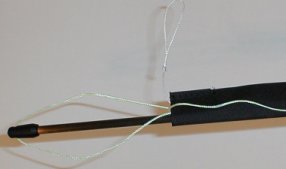
Pass the loose end through the nock:
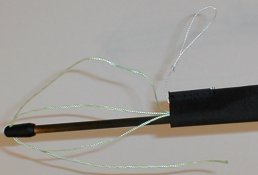
Pull the loose end to tension the leading edge:
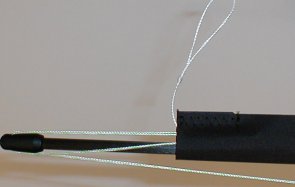
Keeping the tension, wind the loose end around 4 times:
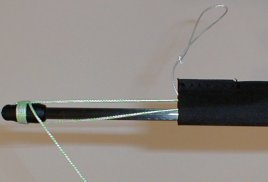
Tuck the loose end under the loop to trap it:
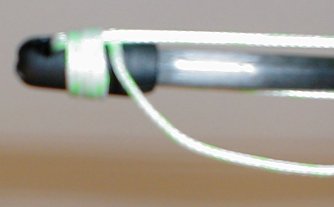
Then put the leech line in the nock:
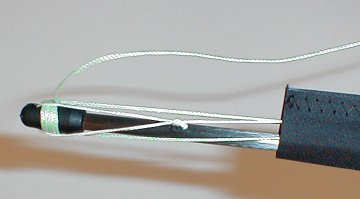
Then just leave the loose end dangling.
Using this method, my leading edges have always stayed tight and never come undone, even in 30mph + winds.
kitemaking/construction.html last modified 19:57:01 30-Jul-2017

This work is licensed under a Creative Commons Attribution-NonCommercial-ShareAlike 2.0 England & Wales License.